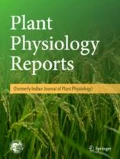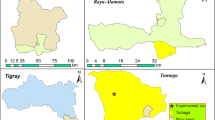Abstract
Decreasing cultivated area and climate variability necessitates adoption of efficient irrigation methods for higher productivity of vegetables. Study was conducted in Kerala State of India on the vegetable crops, namely, chilli, okra and tomato to evaluate the physiological efficiency with mechanistic understanding of plants under wick irrigation method, comparing with conventional irrigation. The crops were evaluated for growth, pigment contents and gas exchange attributes under wick irrigation. Results revealed the efficiency of wick system over conventional irrigation in terms of enhanced growth, significantly (P < 0.001) higher leaf photosynthetic rate, stomatal conductance (10–27%), transpiration rate (11–16%), increased chlorophyll pigment content and nitrogen balance index (NBI), suggesting proper carbon and nitrogen allocation in vegetables grown under wick irrigation method. Similarly, water use efficiency was significantly (P < 0.001) increased in crops under wick irrigation.The study further observed reduction in canopy temperature by 1.86 to 2.84 °C under wick irrigation, indicating uniform distribution of water near the root zone, mediating the optimal transpiration cooling in vegetable crops, when compared to conventional irrigation. The study concludes that wick irrigation maintains the physiological status of vegetable crops and could be a viable option for vegetable production for urban agriculture.






Similar content being viewed by others
References
Abidin, M. S. Z., & Bin, M. S. (2014). Capillary-based subsurface irrigation system for water-saving agriculture (Doctoral dissertation, University of Agriculture and Technology).
Bainbridge, D. A. (2001). Buried clay pot irrigation: a little known but very efficient traditional method of irrigation. Agricultural Water Management, 48(2), 79–88.
Bainbridge, D. A. (2002). Alternative irrigation systems for arid land restoration. Ecological Restoration, 20(1), 23–30.
Brunetti, C., Di Ferdinando, M., Fini, A., Pollastri, S., & Tattini, M. (2013). Flavonoids as antioxidants and developmental regulators: relative significance in plants and humans. International Journal of Molecular Sciences, 14(2), 3540–3555.
Bryant, H., & Yeager, T. (2002). Production of Spathiphyllum using three irrigation methods. In Proc. Southern Nursery Assn. Res. Conf., 47, 596–599.
Cartelat, A., Cerovic, Z. G., Goulas, Y., Meyer, S., Lelarge, C., Prioul, J. L., et al. (2005). Optically assessed contents of leaf polyphenolics and chlorophyll as indicators of nitrogen deficiency in wheat (Triticumaestivum L). Field Crops Research., 91(1), 35–49.
Cerovic, Z. G., Masdoumier, G., Ghozlen, N. B., & Latouche, G. (2012). A new optical leaf-clip meter for simultaneous non-destructive assessment of leaf chlorophyll and epidermal flavonoids. PhysiologiaPlantarum, 146(3), 251–260.
Chaturvedi, A. K., Surendran, U., Gopinath, G., MadhavaChandran, K., Anjali, N. K., & Mohd. Fasil C.T., . (2019). Elucidation of stage specific physiological sensitivity of okra to drought stress through leaf gas exchange, spectral indices, growth and yield parameters. Agricultural Water Management, 222, 92–104.
Das, S., Das, R., Kalita, P., & Bharali, B. (2020). Developmental processes in hot chilli (Capsicum chinenseJacq.) as affected by elevated carbondioxide and temperature. Plant Physiology Reports., 47, 1–9.
DoES, Kerala, (2016–17). Department of Economics and Statistic, Agricultural Statistics, Govt of Kerala, 2016–17. www.ecostat.kerala.gov.in/images/pdf/.../Agriculture/data/2016-17/rep_agristat_1617.pdf.
dos Santos Farias, D. B., da Silva, P. S. O., Lucas, A. A. T., de Freitas, M. I., de Jesus Santos, T., Fontes, P. T. N., & de Oliveira Júnior, L. F. G. (2019). Physiological and productive parameters of the okra under irrigation levels. ScientiaHorticulturae, 252, 1–6.
Ed ellis, (2012). http://www.eeplants.com/blog/2012/01/03/the-wick-system-an-inexpensive-method-of-sub-irrigation/
FAOSTAT (2016). Food and Agricultural Organization. Online statistical database available at. http://faostat.fao.org).
Ferrarezi, R. S., & Testezlaf, R. (2016). Performance of wick irrigation system using self-compensating troughs with substrates for lettuce production. Journal of Plant Nutrition, 39(1), 147–161.
Flexas, J., Bota, J., Loreto, F., Cornic, G., & Sharkey, T. D. (2004). Diffusive and metabolic limitations to photosynthesis under drought and salinity in C3 plants. Plant biology, 6(3), 269–279.
Fultariya, A., Prajapati, V., & Parmar, M. (2017). A review: Experimental Investigation on Capillary Wick irrigation Technique. Int. J. Adv. Eng. Res. Dev., 2348–4470, 1–3.
Ghozlen, N. B., Cerovic, Z. G., Germain, C., Toutain, S., & Latouche, G. (2010). Non-destructive optical monitoring of grape maturation by proximal sensing. Sensors, 10(11), 10040–10068.
Hoffman, M. L., Buxton, J. W., & Weston, L. A. (1996). Using subirrigation to maintain soil moisture content in greenhouse experiments. Weed science, 44, 397–401.
Joseph, K. (2016). Wick Irrigation-A smart and user-friendly irrigation method for container grown plants. SB Academic Review., 19, 1–18.
Kerala state action plan on climate change, 2014 http://www.moef.gov.in/sites/default/files/KERALA%20STATE%20ACTION%20PLAN%20ON%20CLIMATE%20CHANGE.pdf
Mali, S. S., Jha, B. K., Singh, R., & Meena, M. (2017). Bitter gourd response to surface and subsurface drip irrigation under different fertigation levels. Irrigation and drainage, 66(4), 615–625.
Mali, S. S., Naik, S. K., Jha, B. K., Singh, A. K., & Bhatt, B. P. (2019). Planting geometry and growth stage linked fertigation patterns: Impact on yield, nutrient uptake and water productivity of Chilli pepper in hot and sub-humid climate. ScientiaHorticulturae, 249, 289–298.
Mansfield, T. J., & Atkinson, C. J. (1990). Stomatalbehaviour in water stressed plants. In R. G. Alscher & J. R. Cumming (Eds.), Stress Responses in Plants: Adaptation and Acclimation Mechanisms (pp. 241–264). New York: Wiley-Liss.
Medrano, H., Tomás, M., Martorell, S., Flexas, J., Hernández, E., Rosselló, J., et al. (2015). From leaf to whole-plant water use efficiency (WUE) in complex canopies: Limitations of leaf WUE as a selection target. The Crop Journal, 3(3), 220–228.
Mungai, M. M., Wariara, K., Gathogo, H. P., Mwibanda, W. J., & Ochieng, A. A. (2017). Water use and plant growth of selected container grown ornamental plants under capillary wick based irrigation system and conventional irrigation system in Kenya. Int. J. Agron. Agric. Res, 11, 32–41.
Savić, S., Stikić, R., Radović, B. V., Bogičević, B., Jovanović, Z., & Šukalović, V. H. T. (2008). Comparative effects of regulated deficit irrigation (RDI) and partial root-zone drying (PRD) on growth and cell wall peroxidase activity in tomato fruits. ScientiaHorticulturae, 117(1), 15–20.
Seibt, U., Rajabi, A., Griffiths, H., & Berry, J. A. (2008). Carbon isotopes and water use efficiency: sense and sensitivity. Oecologia, 155(3), 441.
Semananda, N. P., Ward, J. D., & Myers, B. R. (2018). A semi-systematic review of capillary irrigation: the benefits, limitations and opportunities. Horticulturae, 4(3), 23.
Sindhu, R. K., & Puri, V. (2016). Phytochemical, nutritional and pharmacological evidences for Abelmoschusesculentus (L). The Journal of Phytopharmacology., 5(6), 238–241.
Sivakumar, R., Devi, D. D., Chandrasekar, C. N., Santhi, R., & Vijayakumar, R. M. (2014). Impact of drought on gas exchange and physiological parameters and yield in contrasting genotypes of tomato (Solanumlycopersicum). Indian Journal of Plant Physiology, 19(1), 1–7.
Taghvaeian, S., Comas, L., DeJonge, K. C., & Trout, T. J. (2014). Conventional and simplified canopy temperature indices predict water stress in sunflower. Agricultural water management, 144, 69–80.
Tezara, W. M. V. J., Mitchell, V. J., Driscoll, S. D., & Lawlor, D. W. (1999). Water stress inhibits plant photosynthesis by decreasing coupling factor and ATP. Nature, 401(6756), 914–917.
Toth, J., Nurthen, E. J., & Chan, K. Y. (1988). A simple wick method for watering potted plants which maintains a chosen moisture regime. Australian Journal of Experimental Agriculture, 28(6), 805–808.
Wang, C., Shu, L., Zhou, S., Yu, H., & Zhu, P. (2019). Effects of alternate partial root-zone irrigation on the utilization and movement of nitrates in soil by tomato plants. ScientiaHorticulturae, 243, 41–47.
Acknowledgement
The Authors acknowledge the Executive Director, Centre for Water Resources Development and Management (CWRDM), Kerala, India for providing essential support and encouragement for this work. Authors wish to thank the reviewers for constructive comments and the editor for expert views on the manuscript.
Author information
Authors and Affiliations
Corresponding author
Ethics declarations
Conflict of interest
No potential conflict of interest was reported by the authors.
Additional information
Publisher's Note
Springer Nature remains neutral with regard to jurisdictional claims in published maps and institutional affiliations.
Rights and permissions
About this article
Cite this article
Chaturvedi, A.K., Surendran, U., Madhava Chandran, K. et al. Exploring growth, physiological status, yield and water use efficiency of vegetables grown under wick method of irrigation. Plant Physiol. Rep. 26, 64–73 (2021). https://doi.org/10.1007/s40502-020-00565-x
Received:
Accepted:
Published:
Issue Date:
DOI: https://doi.org/10.1007/s40502-020-00565-x




